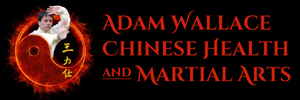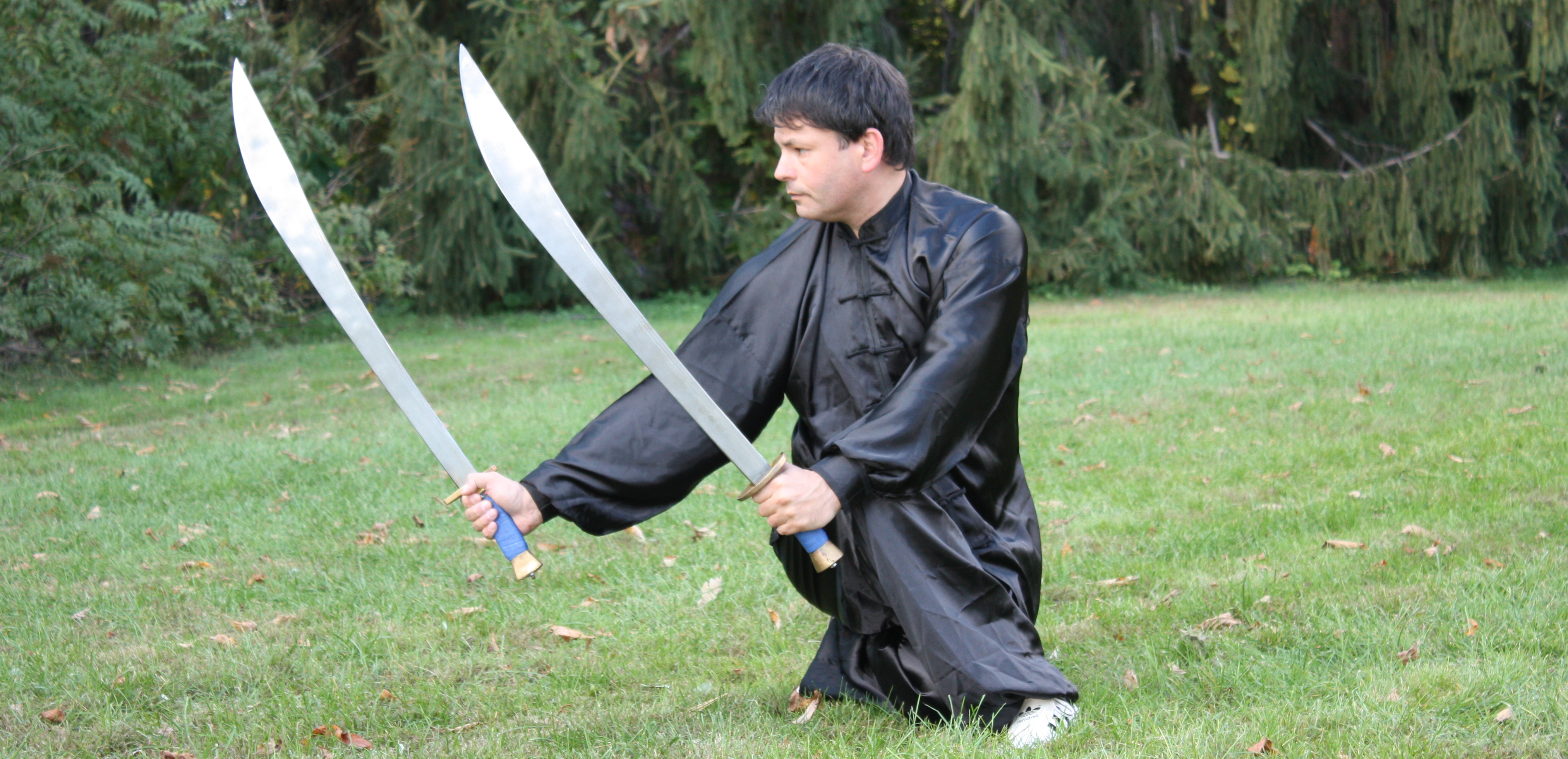Most Chinese martial arts systems will feature some form of weapons training as part of the syllabus. Some styles may feature just one or two weapons (perhaps one short-range and one long-range), while other styles may contain literally dozens of different exotic-looking weapons, from various blades to staff and spear, to rope darts and nine-section whip chains. Even a system, like Kunlun Dayan (Wild Goose) Qigong, though not renowned for its martial arts, actually comprises weapons and empty-hand martial forms in addition to health/ healing skills and spiritual training. However, the Dayan weapons in addition to use for self-defence can be used as special methods to transmit Qi in different ways.
Martial arts can vary in principles, for example some, like Taijiquan and Baguazhang, may follow the circle, while others, like Wing Chun Kuen or Xingyiquan, adhere to the straight line, and the weapons found within each style will generally maintain the principles of the respective art. Chinese systems begin with empty-hand training and then graduate to weapons, while Indonesian or Filipino styles may begin with weapon training from the outset. Either way, weapons make the system complete. Daoist priests were known for carrying swords with them (their Wudang Sword skill was legendary), while Buddhist monks favored the staff, as they preferred to avoid lethal force when self-defence became necessary (having taken the vow of No Killing).
Weapon forms train more complex and intricate co-ordination between hands and footwork (and Mind and Body), taking the student/ practitioner’s abilities, to higher levels, with jumping and spinning, retreating then advancing, and switching directions. Double weapons, such as double broadswords, engage both hands, and the long weapons like staff, spear and halberd, require both hands to manipulate the shaft and end, involving the waist and upper body in conjunction with the legs and lower body. Single weapons (broadsword and straight sword) also engage both hands as the weapon can switch between hands, and most importantly as the empty hand (Yin) must balance in movement with the weapon-holding hand (Yang). Many practitioners focus only on the dominant weapon hand (where the main intention should be) but neglect the empty hand entirely, so miss the perfect balance, flow, and energy.
The practicality of learning to handle a weapon is two-fold. Firstly, it allows for creating greater distance and space between you and an attacker, and it is also useful when an opponent is armed with a weapon. While we may have trained certain weapon disarms, if someone confronts us with a blade or blunt instrument, having a weapon is an equalizer, and often a safer option than facing a weapon unarmed. Once we know how to wield a weapon effectively, any object resembling that particular weapon can be used in its place. For example, if we have trained with a staff or sword then a stick, cane, or umbrella can be used to parry, block, thrust etc. in the same manner.
It is said, “The Pen is Mightier than the Sword”. While this expression relates to words (thoughts and ideas) being more powerful than a weapon, in the sense that words can light brushfires in the minds of people, inspire a call to action, and lead to revolution, in reality a pen in an adept’s hands can well be far more lethal than a sword in untrained hands. In truth, even a regular daily newspaper can become a most lethally offensive weapon (!), when folded tightly and both ends squeezed together to form a handle/ grip. Its reinforced flat surface at the top can become as hard and smooth as solid granite, and the edges of this flattened top become serrated, like a sawtooth blade. So, when airports ban passengers’ mini-scissors or tiny penknives on flights, as part of the ‘security theatre’, perhaps newspapers and pens should be banned too (as they are no less dangerous)?
It is important when training with weapons to choose the most suitable ones for practice, regarding weight and length. Making the wrong choices will negatively impact the result of our practice and skill. To measure the correct length for a spear, as we stand with the spear right by our side and raise our arm straight above our head, the tip of the spear should line up with the tip of the middle finger. If too short, then the spear will fail to provide the necessary range and if too long, the ends will keep hitting the ground when spun. To find the correct length for a sword, we need to hold the hilt of the sword, with our arm down by our side, and the tip of the blade facing up, The tip should come up to no lower than the ear lobe and no higher than the top of the ear (or temple).
Regarding the weight, swords (straight or double-edged swords and broadswords) are available in essentially three types of steel – ‘wushu steel’, ‘spring steel’ and ‘combat steel’. Wushu steel is very thin, lightweight and highly flexible. It is the most preferred for demonstrations, being the easiest to wield, and it renders a magnificent whip-like cracking sound as the tip flexes, which is very dynamic and exciting. This requires thrusting with the correct focused intention, energy, and force. Power is released through the body, and concentrated to the tip of the weapon. Failure to generate sufficient power results in the inability to manifest the cracking sound and flexing. And, if the practitioner is incapable of generating sufficient power using the wushu steel sword, he will not be able to generate the necessary power in the heavier swords, to use the weapon effectively. As wushu steel does not have the weight of a real weapon, by becoming too accustomed to its light weight exclusively means the first time training with a real, heavy (combat steel) sword, some may not even be able to lift it easily, let alone complete the entire form as the muscles and tendons in the arms and wrists will tire and ache. Therefore, it is best to train with the heavier sword so that using any lighter weights then becomes effortless.
Spring steel is the most commonly used for training, providing some weight and balance without requiring too much effort and the body can move more naturally. Combat steel makes for the heaviest swords, taking more effort to wield and can be quite tiring in the beginning, but this is best for developing strength and stamina. Heavier swords, and weapons such as the Da Dao, also known as the Guan Dao (halberd), named after General Guan Yu, really develop the arms and wrists, and back and shoulders, and require using co-ordination of the whole body to wield them correctly. Reportedly, General Guan wielded a Da Dao weighing 100lbs. The lightest training weapons, including wooden swords and telescopic swords may aid with remembering the form (when the real weapon is unavailable or cannot be used in a public place), but they do not provide the weight and balance of a real weapon, and will not build the kind of strength and stamina of the real weapon, nor develop the correct body mechanics needed to wield a more solid weapon, so it is not advisable to train solely with these, as training would be incomplete.
When choosing the right weapon, the final deciding factor should be to judge the “feel” of the weapon in the hand. For example, one time on a training course in UK a friend lent me his staff (as mine remained home in US). Unlike mine, which was polished and smooth, his was knotted and gnarly, but the grooves fitted the grip of my fingers and thumbs perfectly and the weight was perfectly balanced. It almost seemed to come alive while being manipulated and I could feel more of a joy in training the form than I had ever felt. I hope to find a staff like that one day. It is the same for swords. They are not created equal. Most are quite similar and then once you may hold one that just feels “alive” in the hand. It is almost as if the object has its own ‘energy’, and is communicating (some would call it a “Harry Potter Moment”). It is not always easy to find the right tool, and sometimes we just have to make do with what we have. If you happen to find a weapon in a store or trade fair that you make a connection with, you must seize it and not pass it up. You may regret it, as you may never find another one quite like it! This weapon will not only make practice more enjoyable, but will lead to better form as you will want to practice with it more!
When we train empty-hand forms, mind and energy is focused to the fist, fingertips, elbows, shoulders, knees and heels. When we train weapons, Qi is focused outside the body to the tip of the weapon. Weapon training develops greater mental focus and concentration. It absolutely demands focus. A wandering mind or lapse of attention with empty-hand forms rarely can lead to actual physical harm to oneself, but when holding and wielding weapons, it becomes quite dangerous for the mind and eyes to be anywhere other than where they should be at any given time! A momentary lapse of concentration or distraction, taking eyes off the weapon for a second, can result in a painful rap on the shinbone, thigh, knee, ankle, or head, or even a graze, scrape or cut. Though this hardly becomes life-threatening (the ego is hurt more than the physical body), it is most unwelcome when it happens. It is said that our weapon should eventually become like our best friend or partner, and, likewise, if we mistreat our friends and partners they may well retaliate.
Aside from the practicalities and health benefits, training and developing ancient weapons forms serves to keep cultural history alive in the present, and preserves the legacy the ancestors worked so hard to preserve and leave behind for us all to benefit
– Adam Wallace

